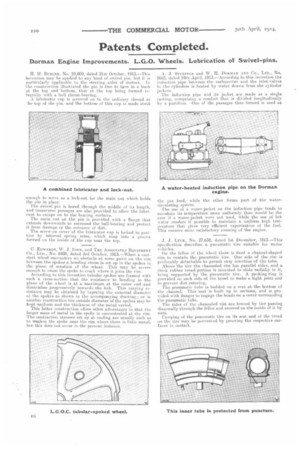Patents Completed.
Page 24

If you've noticed an error in this article please click here to report it so we can fix it.
Dorman Engine Improvements. L.G.O. Wheels. Lubrication of
II. M. Til:TLER, No. 23,800, dated 21st October, 1913.—This invention may be applied to any kind of swivel pin, but it is particularly applicableto the steering axles of motors. In the construction illustrated the pin is free to turn in a bush at the top and bottom, that at the top being formed integrally with a ball thrust-bearing.
A lubricator cup is screwed on to the ordinary thread at the top of the pin, and the bottom of this cup is made stout enough to serve as a lock-nut fur the main nut which holds the pin in place.
The swivel pin is bored through the middle of its length, and transverse passages are also provided to allow the lubricant to escape on to the bearing surfaces. The main nut on the pin is provided with a flange that extends downwards to surround the ball-bearing and protect it from damage or the entrance of dirt. The screw-on cover of the lebricator cup is locked in position by internal spring arms, which snap into a groove formed on the inside of the cup near the top.
C. EL/WARDS, W. J. leene, and Tile AssomaTen Eenneatmer Co., LTD., No. 8408, dated 3rd Oeteber, I913.---3.Vhen a eaststeel wheel e.neetuiters an obstacle at some p&iit on the rim between the spokes a bending stress is set up in the spokes in the plane of rotation of the wheel This may be severe enough to cause the spoke to crack where it joins the rim. According to this invention tubular spokes are formed with such a cross-section that the resistaiwe to betiding in the plane of the wheel is at a maximum at the outer end and diminishes progressively towards the hub. This varying resistanee may be obtained by tapering the external diameter of the spokes as shown in the accompanying drawing; or in another construction the outside diameter of the spokes may be kept uniform and the thickness of the metal varied.
This fatter construetion offers other advantages in. that the larger mass of metal in the spoke is concentrated at. the rim. The contraction stresses vet up at cooling see usually such as to weaken the spoke near the rim where there is little metal, brethis does not occur in the present instance. A. J. SITTINGS and W. H. DORMAN AND CO., LTD., No. 9693, dated 24th April, 1913.—According to this invention the induction pipe between the carburetter and the inlet-valves to the cylinders is heated by water drawn from the cylinder jackets.
The induction pipe and its jacket are made as a single casting, comprising a conduit that is divided longitudinally by a partitiou. One of the passages thus formed is used as the gas lead, while the other forms part of the water. circulating system.
The use of a water-jacket on the induction pipe tends to maintain its temperature more uniformly than would be the ease if a water-jacket were not used, while the use of hot water renders it possible to maintain a uniform high temperature that gives very efficient vaporization of the fuel. This ensures more satisfactory running of the engine.
J. J. Lieme, No. 27,638, dated 1st December, 1913.—This specification describes a pneumatic tire suitable for motor vehicles.
On the feline of the wheel there is fixed a channel-shaped rim to contain the pneumatic tire. One side of the rim is preferably detachable to permit easy insertion of the tube.
Above the tire the channeled rim has parallel sides, and a thick rubber tread-portion is mounted to slide radially in it, being supported by the pneumatic tire. A packing-ring is provided on each side of the tread to make a tight joint and to prevent dirt entering.
The pneumatic tube is bedded on. a seat at the bottom of the channel. This seat is built up in sections, and is provided with flanges to engage the beads on a cover surrounding the pneumatic tube. The sides ef the channeled rim are braced by ties passing diagonally through the felloe and secured on the inside of it by nuts.
Creeping of the pneumatic tire on its seat and of the tread on the tire may be prevented by grooving the respective surfaces in contact.
























